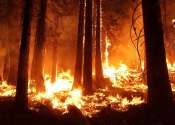Team charts new understanding of actin filament growth in cells
University of Oregon biochemists have determined how tiny synthetic molecules disrupt an important actin-related molecular machine in cells in one study and, in a second one, the crystal structure of that machine when bound ...








